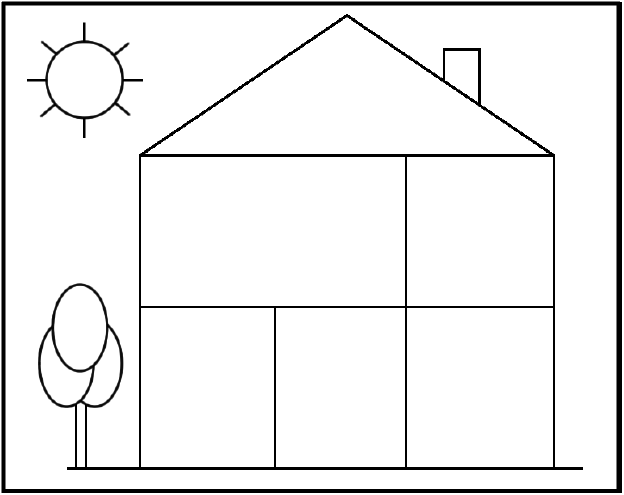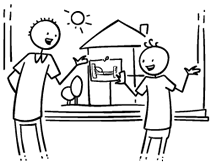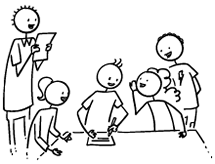 How to teach rooms of a house to kids learning English?
How to teach rooms of a house to kids learning English?
Below are a few useful teaching points and ideas taken from our free Rooms of a House lesson plan.
Teaching points / tips
1. Teach rooms vocab: Before class, cut out 6 pictures of household objects from a magazine/catalog: one for each of the rooms of a house, for example:
bed (for the bedroom), refrigerator (for the kitchen), shower (for the bathroom), TV (for the living room), dining table (for the dining room), flowers (for the garden).
On the board draw a picture of a house, similar to below. Make sure you draw it as big as possible to fill the board.

Elicit the words house, tree and sun. You can also teach/elicit “roof” and “chimney” as extra vocab.
 Next, hold up the cut out “bed” magazine picture and elicit/teach the word. Ask one student to come up to the board stick the picture in one of the rooms (make sure it is the large, upstairs room). Do the same with the other 5 pictures, each time eliciting the word and getting a student to stick on your house so that each room has a picture in it (and one outside in the garden).
Next, hold up the cut out “bed” magazine picture and elicit/teach the word. Ask one student to come up to the board stick the picture in one of the rooms (make sure it is the large, upstairs room). Do the same with the other 5 pictures, each time eliciting the word and getting a student to stick on your house so that each room has a picture in it (and one outside in the garden).
Now, elicit/teach the words for rooms of the house and garden: point at the bedroom and ask “What room is this?”. If no one knows, say, “Well, it has a bed and it is a room, so it’s a …” and try and elicit “bedroom”. Then write the word in the room and chorus 3 times.
Do a similar thing with the other places, e.g.
- bathroom: a room with a bath
- living room: a room where we live
- dining room: a room where we eat dinner (dinner room … dining room)
- kitchen/garden: not compound words so can’t teach this way – just teach and chorus.
 2. Play the “Rooms of a house Quiz”: Put your students into groups (of 2-6 students per group, depending on how many students are in your class). Get each group to elect a team captain and then give each captain a piece of paper and pencil. Tell the captains to write the numbers 1 to 12 down the left-side of the paper. Each captain is going to write the 12 answers to the quiz questions on this sheet, but the rest of the group will help give him/her the answers.
2. Play the “Rooms of a house Quiz”: Put your students into groups (of 2-6 students per group, depending on how many students are in your class). Get each group to elect a team captain and then give each captain a piece of paper and pencil. Tell the captains to write the numbers 1 to 12 down the left-side of the paper. Each captain is going to write the 12 answers to the quiz questions on this sheet, but the rest of the group will help give him/her the answers.
The teacher reads out the following questions as the groups write the answers on their sheets:
- Where in the house do you brush your teeth? (bathroom)
- Where in the house do you cook food? (kitchen)
- Where in the house do you sleep at night? (bedroom)
- Where in the house do you eat dinner? (dining room)
- Where in the house do you sit with your family and watch TV? (living room)
- Where do you see grass? (garden)
- Where are your books, toys and games (bedroom)
- Where are the dishes washed? (kitchen)
- Where can you sunbathe? (garden)
- Where does your family relax together? (living room)
- Where can you get wet inside your house? (bathroom)
- Where is the largest table? (dining room)
Finally, go through the answers with the class by pointing to the correct room on your board picture and helping out with any vocab that students don’t understand. The winning group gets a round of applause from everyone.
3. Do “Rooms of a house Posters”: Put your students into 6 groups (for smaller classes, 3 groups is fine). Give each group the following:
- one large piece of card / construction paper
- a magazine/catalog with lots of photos of household objects (at
- least one per group)
- scissors and glue
Assign each group a room of a house (or garden) and get the groups to write the room name at the top of their construction paper. So, for example, one group will make a “bedroom” poster, another a “living room poster”, etc. If your class is small and you only have 3 groups, each group will have two pieces of construction paper (therefore they will do two room posters).
Tell everyone to look through their magazines/catalogs and cut out pictures to stick on their poster for their room. Demonstrate this with one room before you start to make sure everyone understands (e.g. in living room: a sofa, a TV, rug, coffee table, etc.). Give students 5 minutes for this.
When each group has finished, tell everyone that they have to write the words for the things they have stuck on their posters. Having picture dictionaries or even use of a computer is ideal for students to find the words. Another alternative is a catalog in English. If you don’t have any of these resources, you can help students with the words they don’t know. By the end, all of the pictures should be labeled correctly.
4. When all of the posters are complete, get each group to stick theirs to the walls of the classroom. Groups can then present their posters to the rest of the class.

Additional Activities
Why not try adding these to your lesson from our website?
- download our practice worksheet “Objects in my house”.
- download our homework worksheet “Home Plan”.
- download our rooms-themed classroom reader “Mr. Stretch’s House“.
- download our home & rooms flashcards to use in this this lesson.
Full Lesson Plan
Download and print our full Rooms of a House lesson plan from our lesson plans page.
Includes 2 worksheets and a classroom reader.


